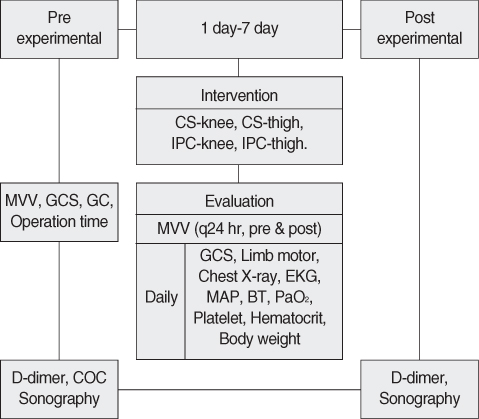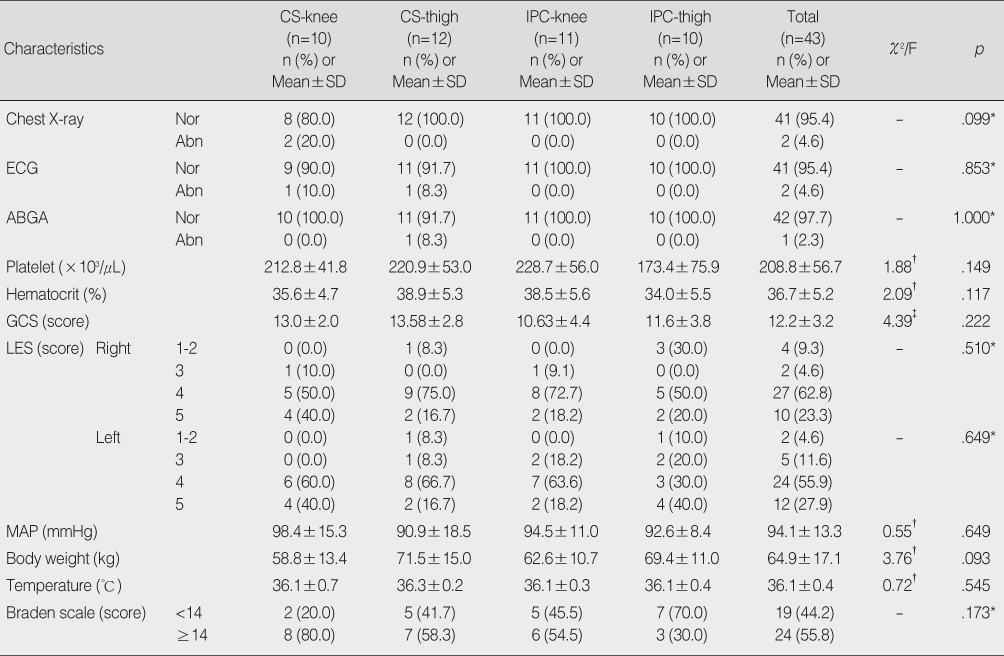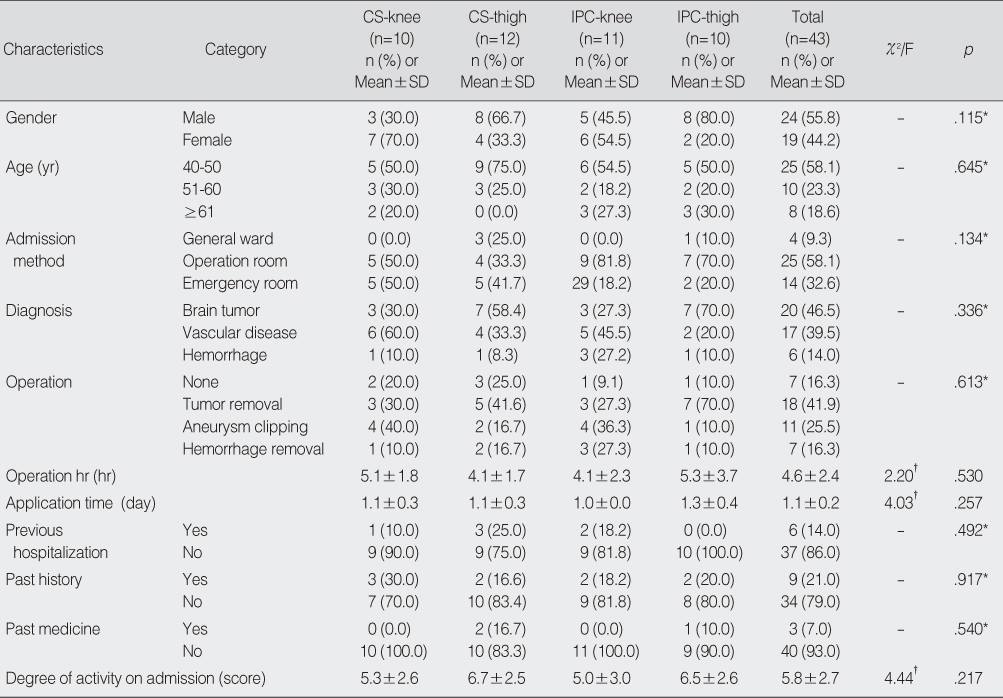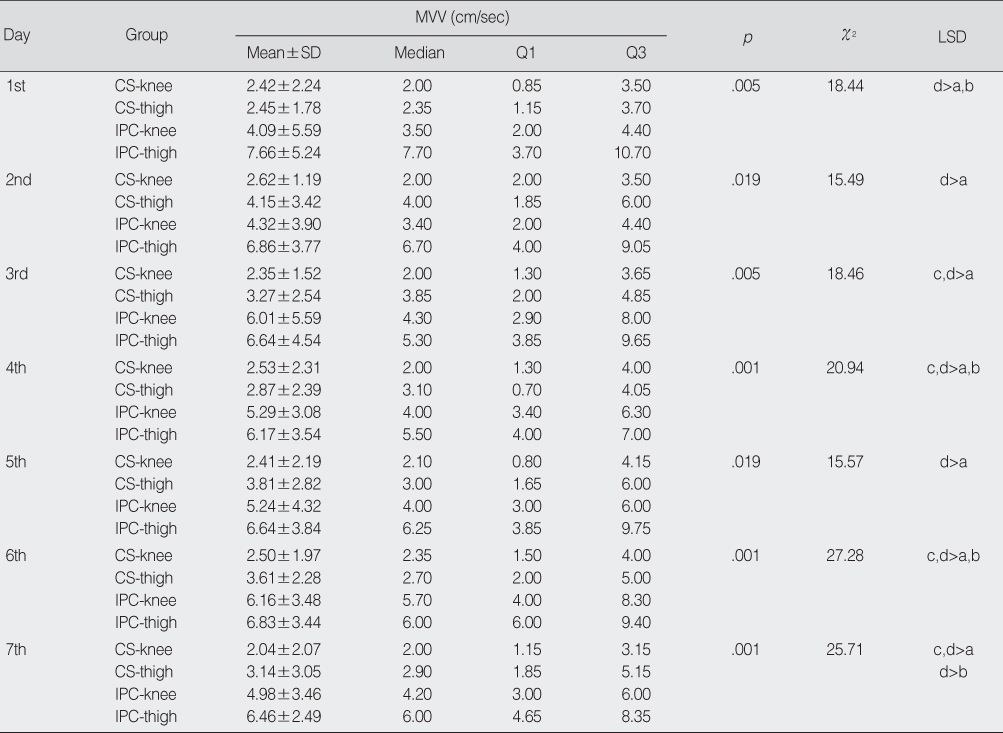Articles
- Page Path
- HOME > J Korean Acad Nurs > Volume 39(2); 2009 > Article
-
Original Article
- Effects on Changes in Femoral Vein Blood Flow Velocity with the Use of Lower Extremity Compression for Critical Patients with Brain injury
- Jung Sook Kim, Hye Jung Kim, Yun Hee Woo, Ji Young Lym, Chul Hyung Lee
-
Journal of Korean Academy of Nursing 2009;39(2):288-297.
DOI: https://doi.org/10.4040/jkan.2009.39.2.288
Published online: April 28, 2009
1Nursing Director, Intensive Care Unit, Samsung Medical Center Concurrent Professor, Sungkyunkwan University Graduate School of Clinical Nursing Science, Seoul, Korea.
2Nurse, Neurosurgical Intensive Care Unit, Samsung Medical Center, Seoul, Korea.
3Registered Vascular Technologist, Vascular Lab, Samsung Medical Center, Seoul, Korea.
- Address reprint requests to: Kim, Hye Jung. Neurosurgical Intensive Care Unit, Samsung Medical Center, 50 Irwon-dong, Gangnam-gu, Seoul 135-710, Korea. Tel: 82-2-3410-3958, Fax: 82-2-3410-3983, monica1649@daum.net
Copyright © 2009 Korean Society of Nursing Science
Abstract
-
Purpose
- This study was done to evaluate the mean venous velocity (MVV) response with knee and thigh length compression stockings (CS) versus intermittent pneumatic compression (IPC) devices in immobile patients with brain injuries.
-
Methods
- We carried out a randomized controlled study. We analyzed both legs of a randomly chosen sample of 43 patients assigned to one of 4 groups (86 legs). The patients were sequentially hospitalized in the intensive care unit (ICU) in "S hospital" from November 2005 to December 2006. The base line and augmented venous velocity was measured at the level of the common femoral vein. We applied leg compression 42 times over 7 days (for 2 hours at a time at 2 hour intervals).
-
Results
- There was a statistical difference among the 4 groups. The difference for the "IPC" group was more significant than the "CS" group.
-
Conclusion
- These results indicate that the application of IPC can be considered as an effective method to prevent deep vein thrombosis for immobile patients with brain injury.
This study was financially supported by the research fund of Nursing department of Samsung Medical Center in 2006.
- 1. Ascher E, Depippo PS, Hingorani A, Yorkovich W, Salles-Cunha S. Does repeat duplex ultrasound for lower extremity deep vein thrombosis influence patient management? Vascular and Endovascular Surgery. 2004;38:525–531.ArticlePubMedPDF
- 2. Byrne B. Deep vein thrombosis prophylaxis: The effectiveness and implications of using below-knee or thigh-length graduated compression stockings. Heart & Lung. 2001;30:277–284.Article
- 3. Choi JY, Park SJ. A comparison of interventions recorded in nursing notes between acute and subacute stage after a cerebrovascular accident. Journal of Korean Academy of Nursing. 2006;36:227–235.PubMed
- 4. Choi KS. A study of patients with head injuries. Journal of Korean Academy of Nursing. 1992;22:517–528.
- 5. Demolis P, Tran Dinh YR, Giudicelli JF. Relationships between cerebral regional blood flow velocities and volumetric blood flows and their respective reactivities to acetasolamide. Stroke. 1996;27:1835–1839.ArticlePubMed
- 6. Hameed MF, Browse DJ, Immelman EJ, Goldberg PA. Should knee-length replace thigh-length graduated compression stockings in the prevention of deep-vein thrombosis? South African Journal of Surgery. 2002;40:15–16.PubMed
- 7. Handoll HH, Farrar MJ, McBirnie J, Tytherleigh-Strong G, Milne AA, Gillespie WJ. Heparin, low molecular weight heparin and physical methods for preventing deep vein thrombosis and pulmonary embolism following surgery for hip fractures. Cochrane Database of Systematic Reviews. 2003;2002, CD000305.
- 8. John A, Heit M. Risk factor for venous thromboembolism. Clinics in Chest Medicine. 2003;24:1–12.ArticlePubMed
- 9. Jung DY, Kim Y, Kwon OY. Effect of deep breathing exercise and ankle exercise on blood flow velocity in the femoral vein. Journal of the Korean Academy of University Trained Physical Therapist. 2002;9:107–113.
- 10. Keith SL, McLaughlin DJ, Anderson FA Jr, Cardullo PA, Jones CE, Rohrer MJ, et al. Do graduated compression stockings and pneumatic boots have and additive effect on the peak velocity of venous blood flow? Archives of Surgery. 1992;127:727–730.PubMed
- 11. Kim YS. Effects of the application of elastic compression stockings on edema and pain of lower extremities in hospital nurses. 2005;Daegu, KeiMyung University. Unpublished master's thesis.
- 12. Kurtoglu M, Yanar H, Bilsel Y, Guloglu R, Kizilirmak S, Buyukkurt D, et al. Venous thromboembolism prophylaxis after head and spinal trauma: Intermittent pneumatic compression devices versus low molecular weight heparin. World Journal of Surgery. 2004;28:807–811.ArticlePubMedPDF
- 13. Kyrle PA, Eichinger S. Deep vein thrombosis. Lancet. 2005;365:1163–1174.ArticlePubMed
- 14. Lacut K, Bressollette L, Le Gal G, Etienne E, De Tinteniac A, Renault A, et al. Prevention of venous thrombosis in patients with acute intracerebral hemorrhage. Neurology. 2005;65:865–869.ArticlePubMed
- 15. Lee SH, Kim KT. Clinical application of compression treatment. Journal of the Korean Society of Phlebology. 2004;3:25–28.
- 16. Oh J, Yoon CM. Lower extremity edema and pain of nurses and the effect of self leg massage. Journal of Korean Academy of Nursing. 2008;38:278–286.ArticlePubMed
- 17. Phillips L, Macmillan A, Tweed C. Review of intermittent pneumatic compression: An evidence-based therapeutic modality for the prevention of avoidable deep vein thrombosis. Journal of Integrated Care Pathways. 2004;8:55–58.ArticlePDF
- 18. The Standards Task Force of the American Society of Colon and Rectal Surgeons. Practice parameters for the prevention of venous thromboembolism. Diseases of the Colon & Rectum. 2002;43:1037–1047.Article
- 19. Van Blerk D. Evaluating an intermittent compression system for thromboembolism prophylaxis. Professional Nurse. 2004;20(4):48–49.
- 20. Yablon SA, Rock WA Jr, Nick TG, Sherer M, McGrath CM, Goodson KH. Deep vein thrombosis: Prevalence and risk factors in rehabilitation admissions with brain injury. Neurology. 2004;63:485–491.ArticlePubMed
REFERENCES


Figure & Data
REFERENCES
Citations

- Characteristics and Effects of Intermittent Pneumatic Compression Devices Interventions to Prevent Venous Thromboembolism in Critical Care Patients: A Systematic Review of Randomized Controlled Trials
Seang Ryu, Nam Young Kim, Yun-Hee Kim
Korean Journal of Adult Nursing.2024; 36(1): 28. CrossRef - Effect of Elastic Compression Stocking and Kinesio Taping during Heel-raise Exercise on Muscle Activity, Mechanical Properties, and Muscle Fatigue in Healthy Women
SeongHo Yun, Yun Jung Kang, Ji Hyun Kim, Hyeon Hui Do, Seo Young Shin, Su Bin Lee, Jung Won Kwon
The Journal of Korean Physical Therapy.2023; 35(1): 24. CrossRef - Effect of Wearing a Compression Stocking on Electromyogram of the Legs
Ji-Youn Lee, So-Hee Yuk, Hyo-Gyung Yoo, Nam-Ju Hong, In-Cheol Jeon, Dongju Jung
The Korean Journal of Clinical Laboratory Science.2019; 51(2): 185. CrossRef - Adaptation and Effects of the Evidence-based IPC Nursing Protocol on Prevention of Postoperative Venous Thromboembolism
Nam Yong Kim, Eun A Kim, Jae Yeun Sim, Soon Hee Jung, Hye Young Kim, Eun Hee Jang, Jee Hye Shin
Journal of Korean Academy of Nursing Administration.2017; 23(1): 63. CrossRef - A study on the Prevention of Deep Vein Thrombosis and Skin Response of Patients after Intracranial Surgery : By Boots and Calf Intermittent Pneumatic Compression Device
Moo-Yong Cho, Boon-Han Kim, Ki-Sook Kim
Journal of the Korea Academia-Industrial cooperation Society.2016; 17(5): 203. CrossRef - Risk Factors Associated with Venous Thromboembolism in Cancer Patients
Su Jung Lee, Nam Cho Kim
Asian Oncology Nursing.2015; 15(3): 171. CrossRef - Graduated compression stockings for prevention of deep vein thrombosis
Ashwin Sachdeva, Mark Dalton, Sachiendra V Amaragiri, Timothy Lees
Cochrane Database of Systematic Reviews.2014;[Epub] CrossRef - Risk Factors and Features of Critically Ill Patients with Deep Vein Thrombosis in Lower Extremities
Hwasoon Kim, Ok Min Cho, Hyo Im Cho, Ju Yeun Kim
Journal of Korean Academy of Nursing.2012; 42(3): 396. CrossRef - Discomfort on Wearing Thigh-Length Compression Stockings in Orthopedic Surgical Patients
Yun-Hwa Jung, Hye-Sook Min
Journal of muscle and joint health.2012; 19(2): 184. CrossRef

Figure 1
Homogeneity Test for General Characteristics of Participants in the Four Groups (N=43)
*Fisher Exact test; †Kruskal-Wallis test.
CS=compression stocking; IPC=intermittent pneumatic compression.
Homogeneity Test for Risk Factor of Deep Vein Thrombosis in Patients in the Four Groups (N=43)
*Fisher Exact test; †One-way ANOVA; ‡Kruskal-Wallis test.
ABGA=arterial blood gas analysis; Abn=abnormal; CS=compression stocking; ECG=electrocardiograph; GCS=Glasgow coma scale; IPC=intermittent pneumatic compression; LES=lower extremity strength; MAP=mean arterial pressure; Nor=normal.
Comparisons of Averages of 3 MVV Pre-Post Difference among Four Groups (N=86)
a=CS-knee (n=20); b=CS-thigh (n=24); c=IPC-knee (n=22); d=IPC-thigh (n=20).
CS=compression stocking; IPC=intermittent pneumatic compression; LSD=least significant difference; MVV=mean venous velocity; Q1=first quartile; Q3=third quartile.
Comparisons of Difference in Mean Venous Velocity between CS Group and IPC Group after Intervention (N=86)
*Wilcoxon's rank sum test; †t-test.
CS=compression stocking; IPC=intermittent pneumatic compression; MVV=mean venous velocity; Q1=first quartile; Q3= third quartile.
*Fisher Exact test; †Kruskal-Wallis test. CS=compression stocking; IPC=intermittent pneumatic compression.
*Fisher Exact test; †One-way ANOVA; ‡Kruskal-Wallis test. ABGA=arterial blood gas analysis; Abn=abnormal; CS=compression stocking; ECG=electrocardiograph; GCS=Glasgow coma scale; IPC=intermittent pneumatic compression; LES=lower extremity strength; MAP=mean arterial pressure; Nor=normal.
a=CS-knee (n=20); b=CS-thigh (n=24); c=IPC-knee (n=22); d=IPC-thigh (n=20). CS=compression stocking; IPC=intermittent pneumatic compression; LSD=least significant difference; MVV=mean venous velocity; Q1=first quartile; Q3=third quartile.
*Wilcoxon's rank sum test; †t-test. CS=compression stocking; IPC=intermittent pneumatic compression; MVV=mean venous velocity; Q1=first quartile; Q3= third quartile.
 KSNS
KSNS
 E-SUBMISSION
E-SUBMISSION



 Cite
Cite

